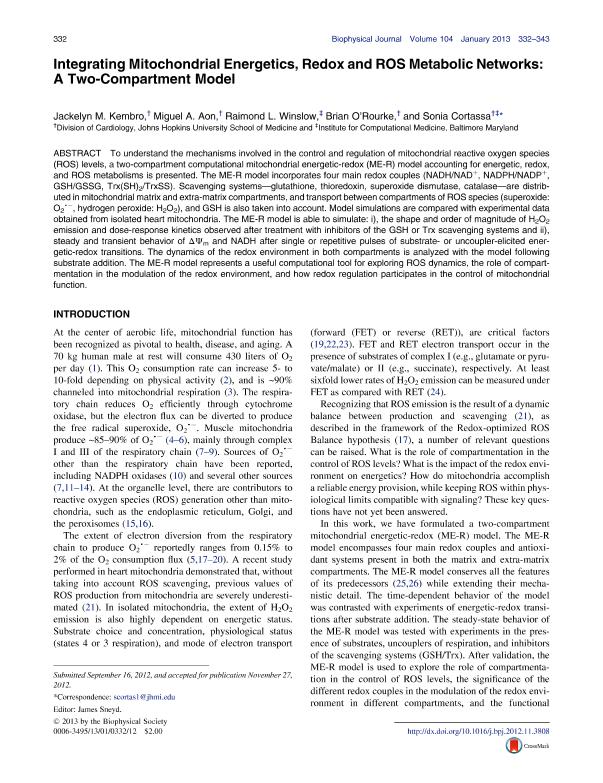Artículo
Integrating mitochondrial energetics, Redox and ROS metabolic networks: a two-compartment model
Kembro, Jackelyn Melissa ; Aon, Miguel A.; Winslow, Raimond L.; O'Rourke, Brian; Cortassa, Sonia del Carmen
; Aon, Miguel A.; Winslow, Raimond L.; O'Rourke, Brian; Cortassa, Sonia del Carmen
 ; Aon, Miguel A.; Winslow, Raimond L.; O'Rourke, Brian; Cortassa, Sonia del Carmen
; Aon, Miguel A.; Winslow, Raimond L.; O'Rourke, Brian; Cortassa, Sonia del Carmen
Fecha de publicación:
01/2013
Editorial:
Elsevier
Revista:
Biophysical Journal
ISSN:
0006-3495
Idioma:
Inglés
Tipo de recurso:
Artículo publicado
Clasificación temática:
Resumen
To understand the mechanisms involved in the control and regulation of mitochondrial reactive oxygen species (ROS) levels, a two-compartment computational mitochondrial energetic-redox (ME-R) model accounting for energetic, redox, and ROS metabolisms is presented. The ME-R model incorporates four main redox couples (NADH/NAD+, NADPH/NADP+, GSH/GSSG, Trx(SH)2/TrxSS). Scavenging systems—glutathione, thioredoxin, superoxide dismutase, catalase—are distributed in mitochondrial matrix and extra-matrix compartments, and transport between compartments of ROS species (superoxide: O2⋅−, hydrogen peroxide: H2O2), and GSH is also taken into account. Model simulations are compared with experimental data obtained from isolated heart mitochondria. The ME-R model is able to simulate: i), the shape and order of magnitude of H2O2 emission and dose-response kinetics observed after treatment with inhibitors of the GSH or Trx scavenging systems and ii), steady and transient behavior of ΔΨm and NADH after single or repetitive pulses of substrate- or uncoupler-elicited energetic-redox transitions. The dynamics of the redox environment in both compartments is analyzed with the model following substrate addition. The ME-R model represents a useful computational tool for exploring ROS dynamics, the role of compartmentation in the modulation of the redox environment, and how redox regulation participates in the control of mitochondrial function.
Palabras clave:
Mitochondria
,
Redox Environment
Archivos asociados
Licencia
Identificadores
Colecciones
Articulos(IIBYT)
Articulos de INSTITUTO DE INVESTIGACIONES BIOLOGICAS Y TECNOLOGICAS
Articulos de INSTITUTO DE INVESTIGACIONES BIOLOGICAS Y TECNOLOGICAS
Citación
Kembro, Jackelyn Melissa; Aon, Miguel A.; Winslow, Raimond L.; O'Rourke, Brian; Cortassa, Sonia del Carmen; Integrating mitochondrial energetics, Redox and ROS metabolic networks: a two-compartment model; Elsevier; Biophysical Journal; 104; 2; 1-2013; 332-343
Compartir
Altmétricas



